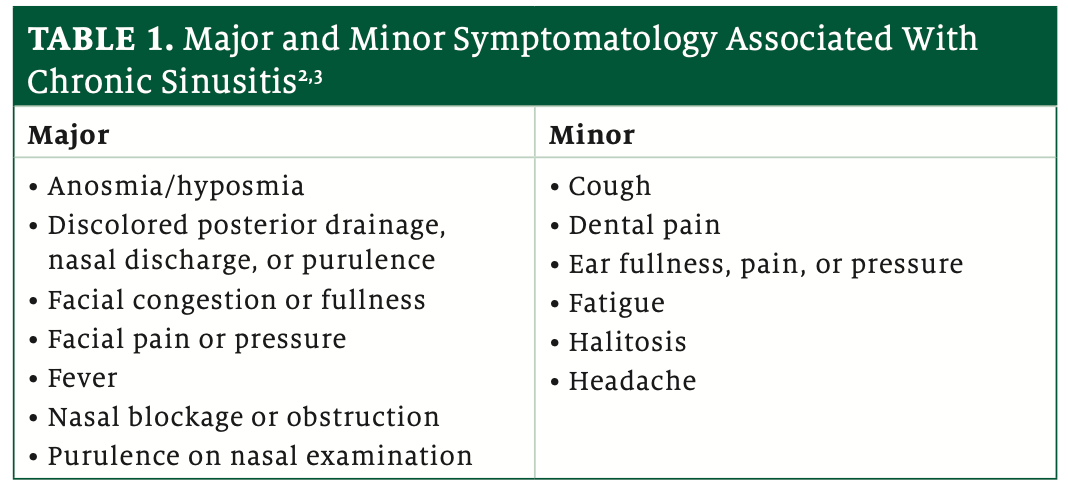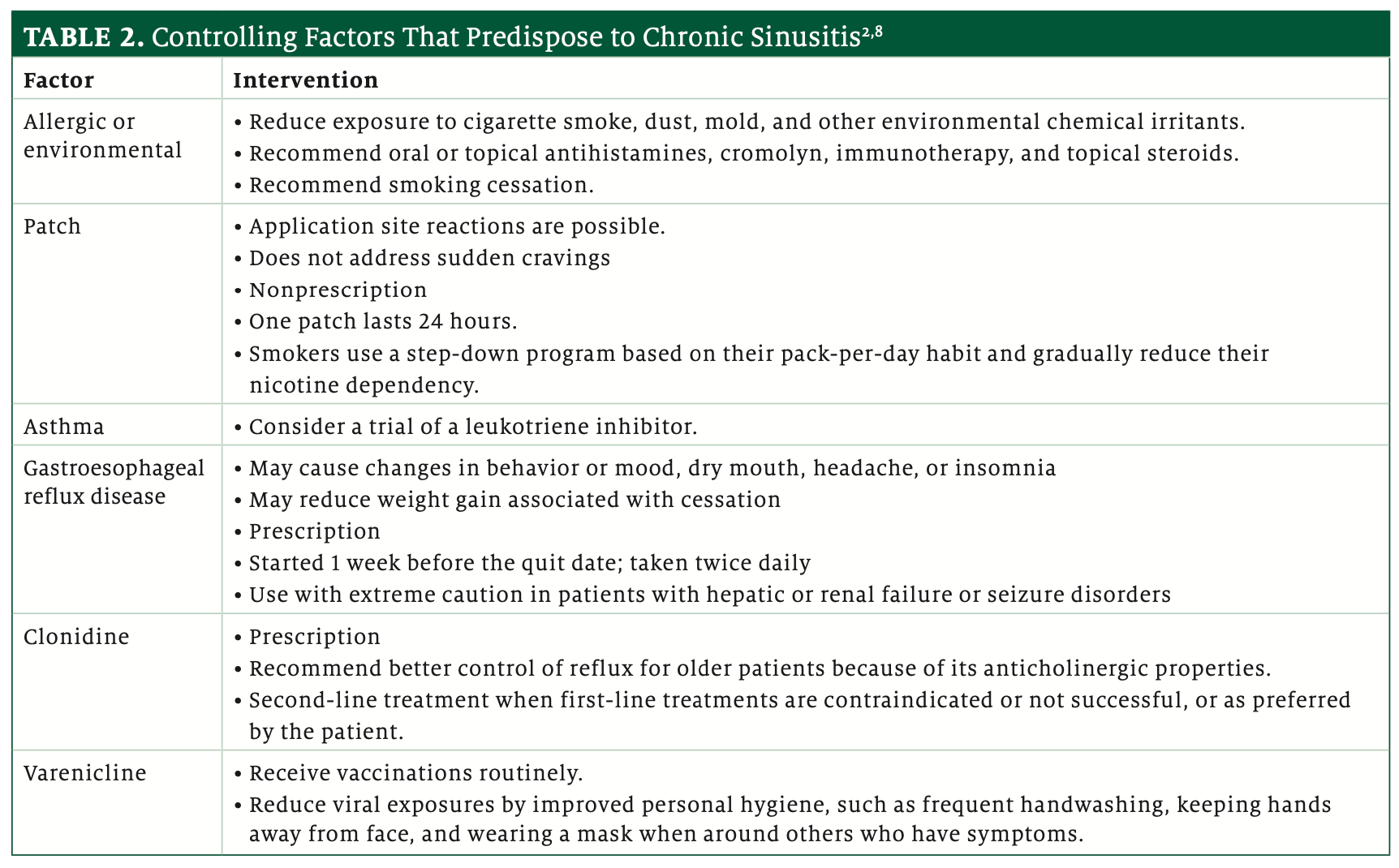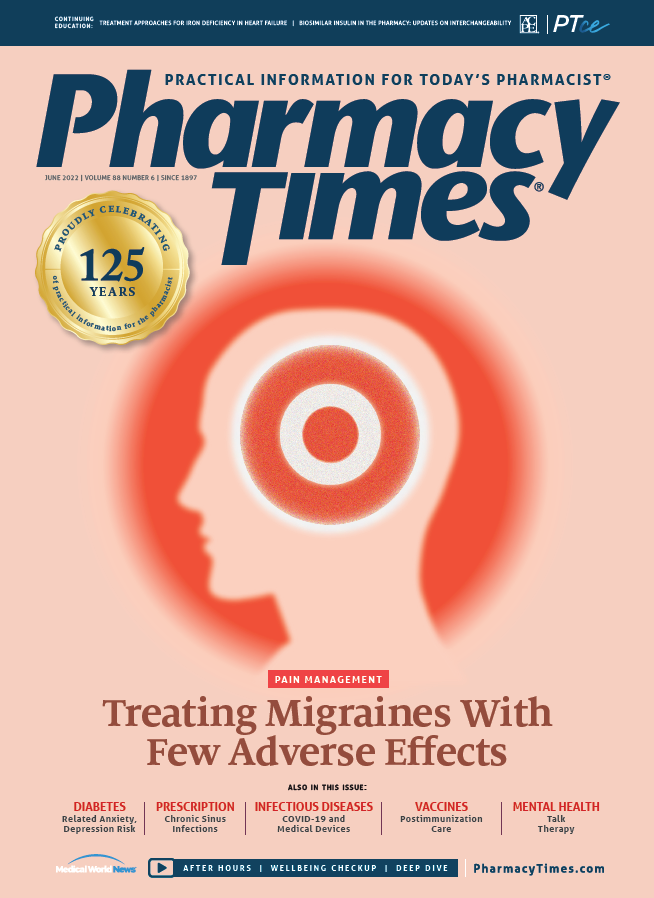Publication
Article
Pharmacy Times
Chronic Sinus Infections Are Costly and Painful
Author(s):
Key Takeaways
- Chronic sinusitis is diagnosed based on symptom duration and severity, with cases lasting over 12 weeks classified as chronic.
- Sinusitis arises from mucosal edema causing obstruction, leading to infection; treatment includes antibiotics, nasal irrigation, and glucocorticoids.
Early intervention, prudent use of antibiotics can help patients treat condition, speed recovery.
When the paranasal sinuses and nasal cavity mucosa become inflamed, individuals often develop intrusive and long-lasting symptoms.
With approximately 30 million Americans experiencing sinusitis annually, pharmacists see their fair share of patients with this condition.1 Chronic sinusitis consumes almost 3 times as much of our health care dollars
($8.3 billion) than acute sinusitis, making it a significant concern.1
When diagnosing sinus infections or rhinosinusitis, clinicians should look at major and minor symptomatology (Table 12,3); diagnosis requires 2 major factors or 1 major and 2 minor factors. Symptom duration also contributes to the diagnosis. Acute sinusitis lasts fewer than 4 weeks and subacute lasts 4 to 12 weeks sinusitis. Once symptoms persist for 12 weeks or longer, the sinusitis becomes chronic by definition. This review focuses on chronic sinusitis.

Mechanics
Sinusitis results from sinus dysfunction when an allergen, bacterial, fungal, or viral assault causes mucosal edema that narrows the sinus ostia, creating mechanical obstruction.4 Obstruction increases pressure in the sinus cavity transiently. As air exchange is impaired and the sinuses lose air, the pressure inside the sinus is lower than atmospheric air pressure. When patients perform normal activities, such as blowing their noses or sniffing, the negative pressure lets nasal bacteria into the sinuses, and they secrete mucous in response. With nowhere to go, fluid accumulates in the sinus, impairing the mucociliary apparatus. The result is painful infection.4
Medical Treatment
Medical therapy with antibiotics, nasal saline irrigation, or oral or topical glucocorticoids attempts to control predisposing factors, help sinus secretions drain, reduce sinus tissue swelling, and treat infections.5 The American Academy of Otolaryngology-Head and Neck Surgery Foundation clinical practice guidelines recommend a measured approach to chronic sinusitis.2 If possible, clinicians should determine whether the condition is bacterial, viral, or noninfectious by culturing sinus aspirates or by endoscopy. They also recommend confirming the diagnosis using anterior rhinoscopy, nasal endoscopy, or CT scan in complicated cases.2
In adults with uncomplicated acute bacterial rhinosinusitis, clinicians can offer watchful waiting, without antibiotics, as most sinusitis is viral, or antibiotic therapy.2,6 Haemophilus influenzae, Moraxella catarrhalis, Staphylococcus aureus, or Streptococcus pneumoniae and other Streptococcus species are most often identified as infectious agents. Initially, prescribers would employ empiric amoxicillin with or without clavulanate for 5 to 10 days.2 If the patient’s sinusitis fails to improve or worsens within 7 days, clinicians should reassess, ruling out other conditions and looking for comorbid conditions, such as asthma, ciliary dyskinesia, cystic fibrosis, and immunodeficiency, which could cause or exacerbate the sinusitis. In addition, clinicians should recommend saline nasal irrigation and/or steam inhalation, topical intranasal corticosteroids, or both for symptomatic relief.2 Further antibiotic treatment should be culture directed. Clinicians should not prescribe antibiotics for viral infection or systemic or topical antifungal therapy in patients with chronic sinusitis.2,7 Concurrently, clinicians should educate patients about controlling predisposing factors (Table 22,8).

Counseling in the Pharmacy
A few points about sinusitis can help pharmacists counsel patients appropriately. In the first 2 weeks of a sinus infection, OTC decongestants, steroid nasal sprays, and saline sprays can often resolve the infection.2,3 After 10 days, if the drainage is colored, an antibiotic, while continuing decongestants, saline spray, and topical steroid sprays, is probably necessary.2
Patients often perceive sinus infection as dental pain because the roots of the upper back teeth are near the sinus cavity and may become painful pursuant to sinus infection.9,10 Sinus pain is positional, changing with movement, so asking whether the pain changes when the patient bends from the waist will pinpoint a sinus infection, whereas dental pain will not change with position. When patients have sinus-related dental pain, large-volume saline irrigation is often helpful.5,10
Some individuals experience lingering symptoms despite the initial course of antibiotics. Sinuses are a closed cavity and eradicating infection may require 3 to 4 weeks of antibiotics, plus additional methods to encourage drainage of the sinuses.2
Longer treatment durations are not associated with improved outcomes.11 Untreated sinus infections can result in intracranial, orbital, and other neurological complications.12
Conclusion
Early intervention is important for sinus infections. In resistant chronic sinusitis, a patient will need a referral to an otolaryngologist for surgical evaluation. Surgery reestablishes sinus ventilation and corrects mucosal opposition to restore the mucociliary clearance system.
About The Author
Jeannette Y. Wick, RPh, MBA, FASCP, is the assistant director of the Office of Pharmacy Professional Development at the University of Connecticut in Storrs.
References
1. Pleis JR, Lucas JW. Summary health statistics for U.S. adults: National Health Interview Survey, 2007. Vital Health Stat 10. 2009;(240):1-159.
2. Rosenfeld RM, Piccirillo JF, Chandrasekhar SS, et al. Clinical practice guideline (update): adult sinusitis. Otolaryngol Head Neck Surg. 2015;152(suppl2):S1-S39. doi:10.1177/0194599815572097
3. Lanza DC, Kennedy DW. Adult rhinosinusitis defined. Otolaryngol Head Neck Surg. 1997;117(3 Pt 2):S1-7.doi:10.1016/s0194-5998(97)70001-9
4. Beule AG. Physiology and pathophysiology of respiratory mucosa of the nose and the paranasal sinuses. GMS Curr Top Otorhinolaryngol Head Neck Surg. 2010;9:Doc07. doi:10.3205/cto000071
5. Chong LY, Head K, Hopkins C, et al. Saline irrigation for chronic rhinosinusitis. Cochrane Database Syst Rev. 2016;4(4):CD011995. doi:10.1002/14651858.CD011995.pub2
6. Treating sinusitis. ChoosingWisely.org. April 2012. April 20, 2022. https://www.choosingwisely.org/patient-resources/treating-sinusitis-aafp/?highlight=sinusitis
7. Charting a fifty percent drop in antibiotics use. ChoosingWisely.org. Accessed April 20, 2022. https://www.choosingwisely.org/resources/updates-from-the-field/charting-a-fifty-percent-drop-in-antibiotics-use/?highlight=sinusitis
8. Fokkens WJ, Lund VJ, Mullol J, et al. EPOS 2012: European position paper on rhinosinusitis and nasal polyps 2012. A summary for otorhinolaryngologists. Rhinology. 2012;50(1):1-12. doi:10.4193/Rhino12.000
9. Sharma GK, Lofgren DH, Taliaferro HG. Recurrent acute rhinosinusitis. In:StatPearls. StatPearls Publishing; December 15, 2021.
10. Renton T. Tooth-related pain or not? Headache. 2020;60(1):235-246. doi:10.1111/head.13689
11. Sreenath SB, Taylor RJ, Miller JD, et al. A prospective randomized cohort study evaluating 3 weeks vs 6 weeks of oral antibiotic treatment in the setting of “maximal medical therapy”for chronic rhinosinusitis. Int Forum Allergy Rhinol. 2015;5(9):820-828. doi:10.1002/alr.21542
12. Ziegler A, Patadia M, Stankiewicz J. Neurological complications of acute and chronic sinusitis. Curr Neurol Neurosci Rep. 2018;18(2):5. doi:10.1007/s11910-018-0816-8

Newsletter
Stay informed on drug updates, treatment guidelines, and pharmacy practice trends—subscribe to Pharmacy Times for weekly clinical insights.





